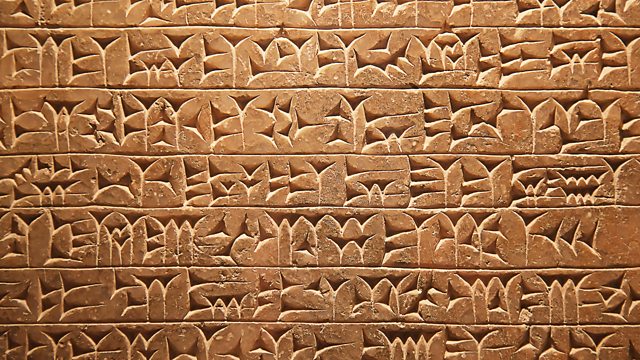Unlocking the mysteries of cuneiform tablets
We explore the origins of cuneiform writing, which developed some 5,000 years ago in Ancient Mesopotamia.
Cuneiform is an ancient writing system distinguished by wedge-shaped marks made into clay. It developed over 5,000 years ago in Ancient Mesopotamia. At its height it was used to write languages across the ancient Middle East, from Iran to Syria to Anatolia in Turkey. But cuneiform writing fell out of use about 2,000 years ago in favour of alphabetic scripts. When scholars in the 19th century finally managed to redecipher it, they discovered fascinating insights into the culture and rituals of people living in the ancient Middle East, unlocking texts that have changed our understanding of history, including The Epic of Gilgamesh, the Code of Hammurabi and The Amarna Letters of Ancient Egypt. And cuneiform has even seen something of a revival in modern-day Iraqi visual culture.
Joining Rajan Datar to discuss cuneiform script are Professor Eleanor Robson of University College London, Dr Mark Weeden of SOAS, University of London and Ahmed Naji, author of 'Under The Palm Trees: Modern Iraqi Art with Mohamed Makiya and Jewad Selim'.
Image: Cuneiform writing of the ancient Sumerian or Assyrian civilisation in Iraq
Image credit: Getty Images
Last on
More episodes
Broadcasts
- Thu 26 Nov 2020 10:06GMT91热爆 World Service
- Fri 27 Nov 2020 00:06GMT91热爆 World Service
- Sat 28 Nov 2020 16:06GMT91热爆 World Service News Internet
- Sun 29 Nov 2020 15:06GMT91热爆 World Service except East and Southern Africa, News Internet & West and Central Africa
- Mon 30 Nov 2020 03:06GMT91热爆 World Service
Featured in...
![]()
Technology and innovations—The Forum
Machines, materials and methods that changed how the world works
Do you think political or business leaders need to be charismatic? Or do you prefer highly competent but somewhat stern people?
Podcast
-
![]()
The Forum
The programme that explains the present by exploring the past




